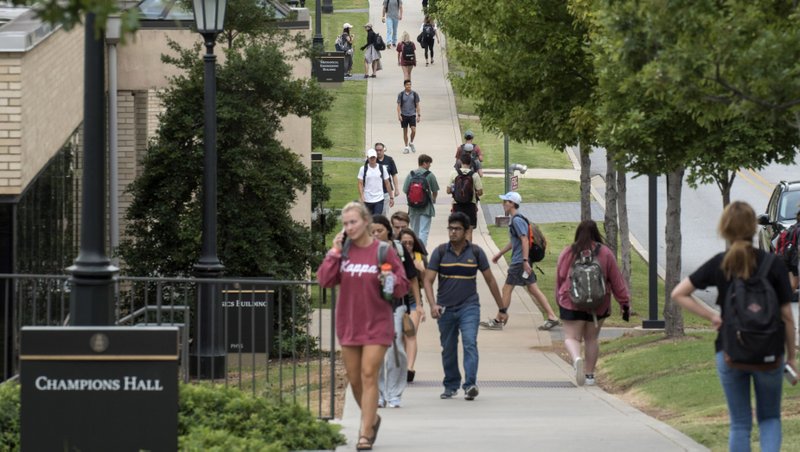More federal grant money supporting University of Arkansas, Fayetteville research helped boost the school's ranking in an annual survey detailing research activity in higher education.
UA-Fayetteville ranked 128th in total research expenditures with $157,791,000 during the 12-month period that ended June 30 of last fiscal year, according to National Science Foundation data released Tuesday. The total increased from $145,020,000 in research and development expenditures the previous year.
Research can lead to new business development and job creation, said Daniel Sui, UA-Fayetteville's vice chancellor for research and innovation. Potential faculty notice when the research dollars increase, said Sui, who joined UA in October.
"This allows us to bring in the very best faculty because they want to be at a system with upward pointing vectors," Sui said in an email.
The jump from a ranking of 130th in fiscal 2016 marked the third consecutive year that UA has raised its ranking.
"This means we are doing a great job of attracting and retaining the very best researchers nationwide and that we are competitive on the playing field with our peer and aspirant institutions," Sui said.
For some institutions, the research totals included a university and a health science center. Among large public universities in nearby states, UA trailed the University of Kansas, which ranked 78th with $300,319,000 in research spending; Louisiana State University, ranked 88th with $266,177,000 in expenditures; the University of Missouri, ranked 90th with $253,952,000 in spending; Mississippi State University, ranked 94th with $240,972,000 in expenditures; and the University of Tennessee, ranked 107th with $203,800,000 in research spending.

UA-Fayetteville ranked higher than the University of Mississippi, which ranked 139th with $134,542,000 in expenditures.
The total includes research activity tied to the Arkansas Agricultural Experiment Station, a part of the University of Arkansas System Division of Agriculture, said Nick Freyaldenhoven, director of research accounting for UA-Fayetteville.
Federal research dollars to UA from sources such as the National Science Foundation and the U.S. Department of Energy increased to about $46.5 million compared with about $40.6 million the previous year.
"Federal funding is the backbone on which most high ranking research institutions depend," Sui said, adding that federal funding typically goes to specific research areas and allows for the exploration of "cutting edge concepts in depth."
The university and other schools rely on outside funding sources as well as institutional support to pay for various types of research projects.
The largest source of funds for UA-Fayetteville in fiscal 2017 was $54.8 million from state and local government. Freyaldenhoven said that out of this total, $47,053,000 went to research involving the Arkansas Agricultural Experiment Station, or AES.
Of this $47 million, "all except $132,000 is derived from state appropriations AES receives from the state of Arkansas," Freyaldenhoven said in an email.
UA-Fayetteville earlier this month announced a $23.7 million gift from the Walton Family Charitable Support Foundation to recruit faculty and provide various support initiatives for researchers, including help to take their research into the commercial marketplace.
UAMS RANKING
The University of Arkansas for Medical Sciences also saw an increase in federal research dollars but still slid in comparison to other institutions. UAMS ranked 141st with research spending of $128,508,000, down from 136th a year earlier.
"It's really about the dollars, not about the ranking compared to other institutions," said Larry Cornett, UAMS interim vice chancellor for research.
The total research spending increased compared with the $125,378,000 the previous year. Federal dollars increased to about $51.3 million in fiscal 2017 compared to about $49 million the previous year.
"Generally, it's a very competitive process," Cornett said of grants from government sources like the National Institutes of Health or private foundations like the American Heart Association.
"The federal dollars are actually the most difficult to get," Cornett said. He said "maybe 15 to 20 percent" of proposals submitted to the National Institutes of Health end up receiving federal funding.
Research is extremely important to improving peoples' health, Cornett said.
"If you have any sense of history and where new treatments, where new diagnostics have come along, it's been through research. And it's largely been research conducted at academic health centers like UAMS but also other universities as well," Cornett said.
The top administrator at UAMS, Cam Patterson, started on the job June 1. Cornett said an overall strategic plan is under development.
"I would be shocked if we didn't set some fairly lofty goals to grow our research enterprise under his leadership," Cornett said.
UAMS leaders in September described a goal for the Winthrop P. Rockefeller Cancer Institute to become a National Cancer Institute-designated cancer center.
Cornett said one hurdle involves research dollars. At least $10 million annually in funding from the National Cancer Institute is required to qualify for the designation, Cornett said.
"We're probably going to have to have another $2 to 4 million in NCI funding," Cornett said.
FEDERAL DOLLARS
Matt Hourihan, director of the research and development budget and policy program at the American Association for the Advancement of Science, said that, historically, the federal government "has been the No. 1 funder of university R&D."
He said "the last few funding cycles have been very good for scientific research" when it comes to federal appropriations for research agencies, despite proposals by the administration of President Donald Trump.
"The current White House has proposed some historically large cuts for research in the life sciences, physical sciences, energy technology and other areas. And Congress has almost entirely refuted those funding proposals and instead provided some sizable research increases," Hourihan said.
The current federal fiscal year began Oct. 1 and final appropriations are in place for "something like three-quarters" of the federal research and development budget, including appropriations for the U.S. Department of Energy and the National Institutes of Health, Hourihan said.
A government shutdown, mentioned as a possibility by Trump, would affect a few agencies yet to receive final research appropriations, including the National Science Foundation, NASA and the U.S. Department of Agriculture, Hourihan said.
A Section on 11/21/2018
